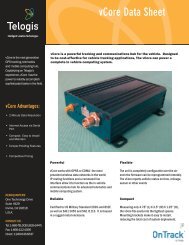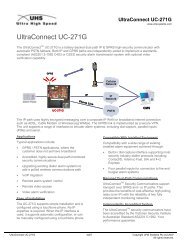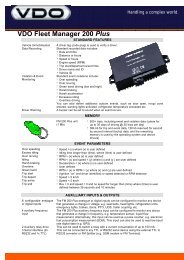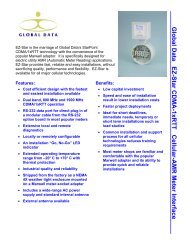Hardware Interface Description - KORE Telematics
Hardware Interface Description - KORE Telematics
Hardware Interface Description - KORE Telematics
You also want an ePaper? Increase the reach of your titles
YUMPU automatically turns print PDFs into web optimized ePapers that Google loves.
XT55/56 <strong>Hardware</strong> <strong>Interface</strong> <strong>Description</strong><br />
Confidential / Released<br />
s<br />
Figure 30 above shows the block diagram of the XT55/56 GPS receiver architecture. The<br />
GPS module can be separated into four major parts: RF frequency down-converter, digital<br />
baseband demodulation, embedded ARM microprocessor and internal GPS software stored<br />
on-board (1 MByte) Flash-Memory. The RF frequency conversion and the baseband<br />
demodulation are executed by hardware while the embedded ARM processor computes the<br />
GPS position, velocity and time solution employing the internal GPS software.<br />
The purpose of the RF circuitry is to reinforce the very weak (-130dBm nominal) GPS signal,<br />
to filter it and to down-convert it to an Intermediate Frequency (IF) of 9.45MHz for digital<br />
processing. The SiRFstarII architecture relies on the high level of integration in the GRF2i to<br />
significantly reduce part count and circuit complexity. A IF filter is built-in as well.<br />
• The digital baseband demodulator takes the quantified GPS signal and detects the<br />
individual satellites serial data bit stream, along with the associated pseudo range. This<br />
action consists of removing spread spectrum and Doppler frequency components of the<br />
signal to obtain the serial data messages.<br />
• The embedded ARM processor monitors channel allocation, extracts the raw satellite<br />
tracking data, computes the position and time solution and sends it on a serial port for<br />
high level applications to use or processes it locally. Support functions for the<br />
microprocessor include real time clock and reset pulse generator circuits. The internal<br />
GPS software monitors and allocates channels, computers the position, velocity and time<br />
using the pseudo-range of the satellites and reformats the data to be output or used<br />
locally. The internal GPS software is a tasking based architecture driven by the 100ms<br />
interrupt generated by GPS2e internal hardware.<br />
4.9 Operation procedure<br />
When the receiver is powered up, it steps trough a sequence of states until it can initially<br />
determine position, velocity and time. Afterwards, the satellite signals are tracked<br />
continuously and the position is calculated periodically.<br />
In order to perform a navigation solution (3D solution), the receiver needs.<br />
• Pseudo-ranges for at least 3 satellites<br />
• Ephemeris data for the satellites it will use in the navigation solution.<br />
Note: If almanac navigation is enabled, the receiver can calculate a position without<br />
downloading ephemeris data (with a significant position error compared to an<br />
ephemeris based solution).<br />
The initial position calculation is made, using a Least-Squares Algorithm. Successive position<br />
calculations are performed with a Kalman Filter. To generate a position (3D solution)<br />
calculation the receiver needs at least 4 measurements to different satellites. In order to<br />
calculate a position (Latitude/Longitude/Height), as a 2D solution with an estimated height<br />
value, then 3 different satellites are required. Pseudo-range and carrier phase information<br />
are available to the position determination algorithms if the receiver has found a SV<br />
(acquisition) and can track the signal thereafter. Ephemeris data for a SV can be decoded<br />
from orbit data once the GPS signal has been acquired. Each SV transmits its own<br />
ephemeris data, the broadcast lasts for 18 seconds, repeating every 30 seconds.<br />
The receiver stores ephemeris data in battery-backed memory. This data can be used in<br />
future startup’s to improve the time to first fix (TTFF). The ephemeris can also be supplied to<br />
the receiver via the serial port.<br />
XT55/56_hd_v02.06a Page 78 of 125 17.12.2004
















